
Argent, a fesse humetty gules: in chief three leopard's faces of the second--BRABANT.
Argent, a fesse dancetty gules; in chief three leopard's faces sable--Sir John POUNTNEY[Lord Mayor of London, 1330, 31, and 33-36].
Argent, on a chevron engrailed sable, between three estoiles gules streaming on the dexter side downwards in bend or, three buck's faces of the first--AYLIFF, co. Wilts.
Argent, three Bacchus' faces, couped at the shoulders clothes gules--BROMALL.
 |
| Faggot. |
Gules, a sword erect argent, hilt and pommel or, enfiled with a ducal coronet of the last between two flaunches of the second, each charged with a faggot proper; [elsewhere blazoned, argent, a chevron sable between faggots of the second]--WOODMONGERS' Company, London, 1716.Failli, (fr.): of a chevron, when broken into one or more pierces.
Argent, on a chevron between three bundles of faggots(or fascines) sable as many bezants--STALWORTH.
 |
| Badge of ANNE BOLEYN. |
 |
| A hawk trussing. |
 |
| CLOSE. |
Sire Thomas de HANVILE, de azure a iij girfauks de or e une daunce[i.e. fesse dancetty] de or--Roll, temp. ED. II.But more especially a falcon, as also a hawk, is represented with the appurtenances which belong to the art of falconry, that is, it is blazoned frequently as belled(fr. grilleté) and jessed of such a tincture.
Sir Johan le FAUCONER, de argent a iij faucouns de goules--Ibid.
Argent, three sparrow-hawks close gules--HAYDOE, Lancaster.
Azure, a goshawk argent--MICHELGROVE.
Sable, three marlion's sinister wings displayed argent--ATCOMB, Devon.
Ermine, a milrind sable; on a chief azure, two marlion's wings or--MILLS, Kent.
Sable, a marlion's wing in fesse argent, between four crosses formy or, two and two--DYNE, Norfolk.
Azure, on a chevron or between three falcons close argent, three roses gules--Nicolas CLOSE, Bp. of Carlisle, 1450; of Lichfield, 1452.
Gules, a chevron between three falcons close argent--RIDLEY, Bp. of Rochester, 1547; of London, 1550-53.
Sable, a falcon rising overt or--Sir Nicolas PECHE.
Gules, a falcon rising, wings expanded argent--HOWELL, Bp. of Bristol, 1644-46.
Sable, a falcon hovering with bells proper over a castle with four towers argent--LANYON, Cornwall.
Or, a falcon surgerant azure beaked or--CARWED, Llwydiarth.
Gules, a hawk reguardant, trussing a bird all argent--GOODWIN.
Gules, a hare argent seized by a goshawk or--DENSKYN.
Sable, a falcon or preying on a duck argent; on a chief of the second a cross botonny gules--MADAN, or MADDEN, Wilts.
Azure, a hawk volant argent seizing a heron also volant or--FOURNIER.
 |
| Hawk's Bell. |
Sable, three hawk's bells or--BELLSCHAMBER.The leash is the line by which a hawks is held(an example us noted under heron).
 |
| WARRE. |
Gules, a hawk's lure argent--WARRE.
 |
| SHANKE. |
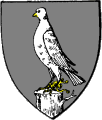 |
| WEELE. |
Sable, a goshawk argent, armed, jessed and belled or--BOLTON.
Sable, two bendlets between three hawk's bells argent--BRADSHAW.
Gules, a lion passant ermine, between three hawk's lures argent--CHESTER, co. Gloucester.
Gules, on a fesse argent, a hawk's lure of the first; in chief a cinquefoil, and in base a hawk's leg, erased, jessed and belled of the second--SHANKE, co. Fife.
Argent, on a bend wavy sable an arm issuing from the sinister of the last; perched on a glove of the first a hawk or--HAWKERIDGE, co. Devon.
D'azur, au faucon d'argent chaperonné de gueules perché sur un tronc d'arbre d'or accompagné en chef de trois tiercefeuilles du même--FAUCON, Auvergne.
D'azur, à un faucon d'or grilleté d'argent empiétant une perdrix aussi d'or, becqueé et ongleé de gueules--VARLET, Bresse.
Argent, a fesse between three hawk's hoods gules--A quartering of KIRTON, Northampton.
D'argent à trois chaperons d'oiseaux liés de gueules--RAPOUEL, Ile de France.
Sable, a hawks standing on a perch argent, beaked and legged or--HAWKER, co. Wilts.
Sable, a goshawk perched on a stock argent, armed, belled and jessed or--WEELE, Devon.
 |
| BAKER. |
Azure, on a chevron between three kite's heads erased or, three roses gules--John KITE, Bp. of Carlisle, 1521-37.Falot, (fr.). See Lantern.
Argent, a chevron between three falcon's heads erased gules beaked or--CASSEY.
Argent, on a fesse gules three falcon's heads of the field--BAKER, Bp. of Bangor, 1723; Norwich, 1727-33.
[Two hawks proper are the supporters to the arms of ROSE of Kilravock.]
Or, a fan displayed with a mount of various devices and colours, the sticks gules; on a chief per pale gules and azure, on the dexter side a shaving-iron over a bundle of fan-sticks tied together or; on the sinister side a framed saw in pale of the last--FANMAKERS' Company[inc. 1709].Fanon, (fr.): this ecclesiastical term, i.e. the ornamentation of the sleeve, or cuff of a priest's vestment, is only found(like the censer) in French heraldry, no English example having been met with.
Argent, on a chevron between three fans(?) gules as many Catherine wheels or--Company of HABERDASHERS, anciently called HURRERS and MILANERS, Cottonian MS., Tiberius, D. 10.
D'argent, a trois fanons de gueules, doublés et frangés de sinople--CLINCHAMPS, Normandie.Farriers' Implements. See Buttrices.
Azure, a fasces in pale or, with axe argent: over all on a fesse gules three estoiles of the second--Cardinal MAZARIN, 1601.Fascines. See Faggot.
Argent, a Roman fasces and sword saltirewise proper; in chief a pair of blances held by an armed arm azure--HOSEASON, Zetland.
Per pale vert and azure, a lion rampant argent crowned or; on a canton ermine two swords in saltire surmounted by a fasces impaled within a wreath all or--DOBEDE, co. Cambridge.
Ecartelé aux 1 and 4 d'argent; aux 2 and 3 d'azur; le 2 à deux faisceaux d'armes antiques, le 3 à un faisceau de même à une bande de gueules brochante sur le tout chargée de trois étoiles d'argent--NADAULT DE BUFFON.
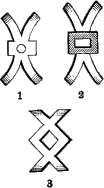 |
| Fers-de-Moulin. |
Sire William SAUNSUM, de or a un fer de molin de sable--Roll, temp. ED. II.Fermaile, (i.e. fer de maille). See Buckle.
Sir Robert de WYLEBI, de goules a un fer de molin de argent--Ibid.
Sire Rauf le MARESCHAL, de or a un fer de molin de goules--Ibid.
Paly of six argent and azure, a milrind of the second--PRICHET, Bp. of Gloucester, 1672-81.
Gules, a fer-de-moline argent--FERRE.
Or, a fer-de-moline azure--MOLYNERS.
Ermine, a fer-de-moline azure pierced of the field--MOLINS, London.
Argent, on a milrind sable five estoiles of the field--VICOREY, co. Derby.
Azure, fifteen fers-de-molines or; on a chief of the second a lion rampant purpure--Insignia of LINCOLN'S INN[according to GUILLIM].
Gules, a mill ink pierced argent--FERE, co. Stafford.
Gules, two bars argent; over all an inkmoline argent--PAUNERTON, co. Stafford.
Gules, a millrind bendways argent between two martlets in pale or--BURNINGHAM, Hants.
Argent, three fern-leaves vert--VERNAI, Devon.Ferris: the old-fashioned means employed in striking a light is found as a charge on one coat of arms.
Azure, a fesse between three adder's-tongue leaves or--BROUNESLANE.
Per pale argent and azure, a ferris counterchanged--BOGNER.
 |
| COLEVILLE. |
Walter de COLEVILLE, dor ung fece de goulz--Roll, temp. HEN. III.The fesse is subjected to the same series of variations as to its margin as have already been noted under the bend, &c., and this from earliest times; the fesse dancetty was called a dauncet, and when indented q.v. the number of indentations is sometimes given. It is also found humetty(q.v.) and even with the ends botonny.
Le Counte de WARWICK de goules crusule de or, a une fesse de or--Roll, temp. ED. II.
Monsire Symon de COLVIL, porte d'or a une fes de gules.
Piers PERCY, d'or ung fece engrele d'azur--Roll, temp. HEN. III.There cannot properly be more than one fesse in a single coat of arms; if more they are bars; but still, in rare instances, in old blazoning the term fesse is used where bar would be used now; the term a demi-fesse occurs also when it is joined with a canton. (See under Canton, arms of PYPARD.)
John de DEYVILLE, d'or ung fece flourey de l'un en l'autre--Ibid.
Argent, a fesse botonny gules--ABIBSON.
Sir John de WAKE, port d'or ov ij fesse de gulez ov iij torteus d'or en la chef.--Falkirk Roll, A.D. 1298, HARL. MS. [But in the Roll in the Cottonian MS. Caligula, A. xviii. A.D. 1308-14, these arms are blazoned, Sire Johan WAKE, de or, a ij barres de goules, en le chef iij rondels de goules].Again, like the chevron, the fesse may be abased, enhanced, &c.
Sir Rauff PIPART, porte d'argent ov ung fees et demy fees et le cantell d'azure; et en le cantell quint foyl d'or--Falkirk Roll, Harl. MS. 6589.
Argent, a fesse enhanced and a chevron gules--MACK.
 |
Gules, a fesse removed or debruised in the centre argent--BROKROSE.It may be charged with various devices, and very rarely is it depressed by other ordinaries, but such cases do occur.
Gules, a fesse ermine depressed by a pale of the same within a bordure engrailed azure--SPONNE.Party per fesse(fr. coupé) is very rare in comparison with party per pale. While the division into three horizontal portions(fr. tiercé), though comparatively common in French arms, is seldom if ever found in English examples. See Party.
Or, a fesse chequy azure and argent, over all a bend engrailed gules within a bordure of the third charged with eight mullets of the second--STUART, co. Oxon.
Gules, a sword lying fesswise proper, hilt and pomel or, the hilt towards the sinister between three fleurs-de-lis of the last--BROWNE, Scotland.
 |
| DOLBEN. |
Sable, a close helmet between three spear-heads, points fesse-wards--DOLBEN, Bp. of Bangor, 1632.Fettered: used in one case of a lion's forefeet. In the case of a horse the term spancelled is used.
 |
| Fetterlock. |
 |
| NUTHALL. |
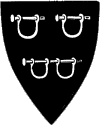 |
| ANDERTON. |
Argent, a shack-bolt sable--NUTHALL, Nuthall, Lancashire.
Gules, five shackles in fesse argent--SHAKERLEY.
Argent, a heart gules, within a fetterlock sable--LOCKHART, Scotland.
A lion's head erased or, within a fetterlock of the last--Crest of WYNDHAM, Earl of Egremont.
Azure, a fetterlock and key argent--MABEN.
Sable, on a bend between two pair of manacles argent three pheons bendwise in bend gules; a chief or charged with a demi-lion rampant issuant enclosed by a pair of lozenges azure--Thomas JOHNSON, co. York.
Argent, a fesse between three fetterlocks[? padlocks] gules--GRIERSON, Dumfries.
Sable, two single shack-bolts and one double one argent--ANDERTON, Chesh. and Lanc. [also blazoned three double shack-bolts].
Argent, an anchor in pale azure, the ring or; the anchor surmounted with a fetterlock of the second, within the fetterlock on the dexter side of the anchor a sword erect of the last, hilt and pomel or; on the sinister side of the anchor a rose gules--Insignia of the town of BEWDLEY, Worcestershire.
 |
| Badge of EDW.IV. |
Per fesse wavy gules and argent, in chief a lion passant guardant erminois, in base on a mount vert a fig-tree proper--MIRTLE.Figured, (fr. figuré): the sun, moon, and some other charges are so termed when drawn with human countenances, as if reflected in them.
Per chevron argent and gules, three fig-leaves counterchanged--GREVES.
Argent, on a fesse engrailed sable, fimbriated or, between two greyhounds courant of the second, three fleurs-de-lys of the third--BAKER.Finches: beneath this term it has been thought well to comprise a number of birds of the finch tribe, examples of which are found in heraldic blazon. In many cases only single instances have been met with, and some appear to have been adopted only for the sake of the name. They are as follows, and for the sake of reference to foreign arms the scientific names according to Linnæus have been added to each: The Goldfinch(carduelis); the Bulfinch(pyrrhula); the Chaffinch(fringilla cœlebs); the Brambling(fringilla montifringilla); the Canary(fringilla canaria); the Linnet(fringilla cannabina), and the Pinzon. This last is the only one of the series which occurs in any of the old rolls, and it has evidently been chosen for the sake of the name. It is not quite certain what is the bird meant, but it has been supposed to be the chaffinch, i.e. the modern fr. pinson. It has not, however, been found possible to fix upon the equivalents of the above in the French lists of arms.
Gules, on a bend sable fimbriated or, two pierced mullets and as many ducks argent membered of the first alternately--Sir Robert RUSSELL.
Argent, a chevron sable between three goldfinches proper--MOLENICK, Cornwall. [Borne also by GOULDSMITH, Kent, and GOOLD, co. Cork.]Finned, of dolphins or fish, when the fins are of another tincture.
Or, a fesse between three bulfinches proper--ALPIN.
Azure, on a bend invected argent between three crescents, each surmounted by a mullet of eight points or as many chaffinches proper--CHAFFERS, Liverpool.
Argent, three bramblings proper; a chief gules--BRAMBLEY.
Sable, on a bend or, three canary birds proper--KINNEIR of that Ilk.
Azure, a chevron argent between three linnets proper--CARDALE, Hagley, 1590.
Sire ... MOUNPYNZON, de argent a un lion de sable a un pinzon de or en le espandle[i.e. on the shoulder]--Roll, temp. ED. II.
Vert, on a chevron argent, between three plates, each charged with a pyncheon(i.e. goldfinch) proper, as many pansies, stalked proper--MORGAN, Bp. of S.David's, 1554-59(grant A.D. 1553, College of Arms).
 |
| Flames. |
 |
| WELLS. |
Or, on a fesse dancette, between three flames of fire gules, a lamb couchant, between two estoiles argent--Ascribed to HOOPER, Bp. of Gloucester, 1550-54; also of Worcester, 1552-53.S.Anthony's Fire is named in the following singular coat of arms:--
Azure, a book open between three flames of fire proper, within a bordure argent, charged with four mullets and so many crosses crosslets as the first--SMITH, Edinburgh.
Ermine, two flames in saltire gules--LEIGHT, Hants.
Azure, flames of fire proper--BRANDER, Hants.
Argent, a chevron voided azure between three(another two) flames of fire proper--WELLS, co. Monmouth.
Argent, a bend between three crescents flammant proper--PADDON, Hants[granted 1590].
Argent, three hearts flammant gules--HEART, Scotland.
Argent, two billets raguled and trunked placed saltirewise, the sinister surmounted of the dexter azure, their tops flaming proper--SHURSTABLE.
Or, on a fesse chequy azure and argent, in chief two stars of the second; quartering argent a galley, oars in action sable with S.Anthony's fire on the topmast, and in the centre of the quarters a crescent for difference--STEWART, Innernytie, Scotland.
 |
| Fire-balls. |
Azure, a fire-ball or flamed proper--DANCASTER, co. Berks, granted 1556.
Argent, a fire-ball proper held in the dexter paw of a lion rampant sable--BALL, co. Chester.
Argent, an eagle displayed or; in chief a naval crown between two bombs of the last fired proper--GRAVES.
Sable, on a fesse ermine between three mullets of the last a bomb-shell bursting proper--BENSLEY, London.
Argent, a chevron between three fire-balls sable fired in four places--BALL, Devon[but it is also blazoned elsewhere as between three balls sable with four tassels].
Argent, on a fesse gules between three grenados sable fired proper a plate--SILVERTOP, Northumberland.
Ermine, a lion rampant sable between in chief two torteaux, and in base a hand grenade exploding proper--BALL, Norfolk.
Paly of six or and gules, on a chief engrailed ermine three hand grenades proper--BOYCOTT, Norfolk.
 |
| Fire-chest. |
Per fess gules and or, in base a wolf passant reguardant vert, holding in his mouth a fish of the third; in chief ... KYERKWALD.As has been already pointed out under dolphin several Lord Mayors of London bore this supposed fish in their arms, by reason of the flourishing condition of the FISHMONGERS' Companies. The two Companies of SALT and STOCK-FISH MONGERS were united in 1536, when they obtained a charter from Henry VIII. In their old Hall, destroyed by the fire of London, there were arms in the windows of twenty-two Lord Mayors, who had been chosen from the Fishmongers' Company.
Azure, three otters passant in pale or, each holding in his mouth a fish argent--PROUDE, Kent.
Vert, three fishes hauriant or, spotted gules--DOGGE.
Azure, a bend engrailed between six fishes hauriant argent--COOPER.
Argent, on two bars wavy azure, three fishes naiant two and one, or in fesse a mount vert, charged with a dove rising, nimbed of the third--HILSEY, Bp. of Rochester, 1535-1538.
Per pale azure and purpure, a fish hauriant or--VAUGHAN, Wales, [Granted 1491].Fish-hook. See Hook.
Gules, a fish naiant argent--HARBRON, co. Chester.
Gules, three fish conjoined at their tails, in triangle or, heads sable--BERNBACK.
Gules, three fishes' heads meeting in the fess point argent--TWYNKYN.
Gules, a fish in bend argent--NEVE.
Argent, two fishes in saltire azure--GEDNEY, co. Lincoln.
Vert, a dolphin urinant(or in pale, tail in chief) or--MONYPENNY, Kent.
 |
| Crosses fitchy. |
 |
| Crosslets fitchy. |
 |
| Double and treble fitched. |
Argent, a pale pointed in base gules between two cinquefoils of the second--ARCHDALL, Ireland.The terms double fitched and treble fitched have been awkwardly applied by heraldic writers to crosses, the ends of which terminate as shewn in the margin. See Cross, §19.
Azure, a chevron between three flags displayed argent--DRUMSON.The Standard, (fr. estendart), is a long flag, gradually becoming narrower towards the point, which, unless the standard belong to a prince of the blood royal, must be split. The following figure is taken from a pedigree of the WILLOUGHBY family, c. temp. Eliz. It may be described as follows:--
Argent, a saltire between four laurel leaves vert, on a chief embattled azure two French flags in saltire, surmounted by a sword erect all proper; over the sword Bourbon in gold letters--Sir Henry KEATING, Justice of the Common Pleas, 1859.
Argent, a lymphad with sail furled on a sea in base proper, at the poop a flag flying towards the bow argent fimbriated vert, charged with a pomme in fesse, on a chief gules three bezants each charged with a mullet--UTTERSON, Sussex.
In the chief, the cross of St.George, the remainder being parted per fesse or and gules[the livery colours], divided into three portions by the white scroll containing the motto. In the first the cognizance--a griffin passant argent, armed blue. In the second crest, an owl crowned proper, upon a wreath of the family colours. The fringe green and white, the colours of the royal house of Tudor.
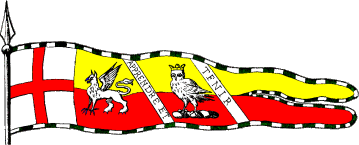 |
| WILLOUGHBY. |
In the chief the cross of S.George, the remainder party per fesse azure and gules, and divided into three portions by a white scroll, bearing--DIEU ET MON DROIT.Standards are sometimes named in coats of arms.
In the first, a Lion of England between in chief a coronet of crosses patés and fleurs-de-lys between two clouds irradiated proper; in base, a cloud between two coronets. In the second, in chief a coronet; in base, an irradiated cloud. The third, quarterly 1 and 4, an irradiated cloud, 2 and 3 a coronet.
Gules, on a standard argent, fringed or, in saltire, with a broken spear of the second, a cross of the first--SMYTH, Scotland[granted 1765.]The Union Jack. The national flag of Great Britain and Ireland is also, properly speaking, a banner and not a flag, but as custom has sanctioned the name, it is given here instead of under banner. It was the banner of S.George(argent, a cross gules), to which the banner of S.Andrew(azure, a saltire argent) was united(instead of being quartered according to ancient custom) in pursuance of a royal proclamation dated April 12, 1606. It would then have been blazoned as follows:--
Argent, three standards(another vanes) sable in an orle gules--VYRNEY.
Azure, a saltire argent, surmounted by a cross gules, fimbriated(more accurately edged) of the second.
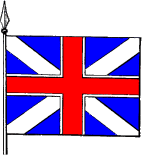 |
| Union Jack, 1707. |
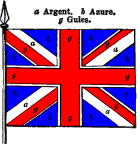 |
| Union Jack, 1801. |
Azure, the saltires of S.Patrick and S.Andrew quarterly per saltire, counterchanged argent and gules; the latter fimbriated of the second; surmounted by the cross of S.George of the third, fimbriated as the last.The word Jack is of doubtful origin, possibly some trifling incident may have given the name. Philologists have derived it from the surcoat, charged with a red cross anciently used by the English soldiery, which was once called a jacque(whence the word jacket): but it is doubtful whether the name Union Jack ever appears before the name jacque had quite gone out of use. Others suggest that the name of Jacques was given by the French in allusion to King JAMES, in whose reign the union took place. But these are more guesses.
Quarterly sable and argent, the first quarter occupied by a lion rampant of the second, over all a representation of the guidon of the Thirty-first Regiment( .... two laurel leaves saltirewise .... below the Union Jack) in bend sinister--BYNG, Earl and Baron Strafford.Pennon: a flag resembling the guidon in shape, but only half the size. It is not to be charged with arms, but only with crests, heraldic and ornamental devices, and mottos.
La ot meint richa guarnement Meint beau penon en lance mis
Brodé sur sendaus e samis Meint banier deploié.
Roll of Carlaverock, A.D. 1300.
Argent, two lances in saltire sable, pennons gules, surmounted by an esquire's helmet azure--CLINKSCALES.A kind of pennon seems also to have been called an ancient, but many of these names appear to be loosely used. See Banner.
Argent, a saltire wavy sable between two human hearts gules in flanks a dexter hand gules holding a cross crosslet azure in chief, and a ship(square rigged) proper with pennants gules in base-John TAYLOR, Orkney.
 |
| Forked pennon. |
A demi-lion argent issuing from a ducal coronet, and holding a pennoncelle gules charged with a lion passant gardant or, the staff of the last--Crest of BROMLEY, Staff. and Warw.Pavon: a triangular flag about four or five yards long, tapering from about half a yard in width to a point, the lower side being at a right-angle to the staff.
 |
| Flag-stone. |
Argent, a chevron between three flag-stones sable--Company of PAVIOURS.Flagon. See Ewer.
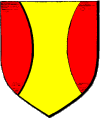 |
| LANERCOST Priory. |
Or, two flaunches gules--LANERCOST PRIORY, Cumberland.In flank, or in the flaunche, is also used to signify at the side; e.g. in a quarterly per saltire in the flanks would be equivalent to the quarters two and three; the French term flanqué is sometimes used instead of accompagné, or accosté, but the flanc is especially used for the extreme edge of the shield, from which, when any charge issues, it is said to be mouvante.
Sable, two talbot's heads couped or, between as many flaunches ermine--HEVAR, London, 1687, and Norfolk.
Argent, three palets azure between two square flaunches gules--MOSYLTON.
Or, three palets, over all two square flanks gules--MOSELTON.
Azure, two talbot's heads erased or, between as many flasques ermine--HERVARE, Marshland.
Argent, three martlets in pale; on two flaunches sable three lions passant of the field--Thomas BROWN, Bishop of Rochester, 1436-1445.
Azure, a saltire between in chief an arrow point upwards argent, in the flaunches and base three hunting horns of the last--POTTOCK, Scotland.Flax-breaker. See Hemp-break.
Argent, two eels paleways waved, between two stars in the flanks azure--ARNEEL, Scotland.
D'azur, au pal d'argent chargé de trois tours de gueules, et accosté(ou soutenu) par quatre jambes de lion d'or mouvantes des flancs de l'ecu--BRANCAS Comtat Venaissen.
 |
| Fleame. |
Quarterly first and fourth sable, a chevron between three flemes argent[i.e. arms granted 1452], second and third per pale argent and vert, a spatula in pale argent surmounted of a rose gules charged with another of the first, the first rose regally crowned proper; between the four quarters a cross of S.George gules, charged with a lion passant gardant or--BARBERS' Company, London, [Barbers' Company incorporated, 1461; then Barbers and Surgeons united, 1540; conferred, 1630; union dissolved, 1745].Flêche, (fr.): arrow.
Ermine, two surgeon's fleams in saltire gules--TYTHERLEY, Hants.
Sable, three fleams argent--RENDACY.
Argent, a chevron gules between three fleams or--CHETHAM, co. Derby.
Gules, two dirks in saltire argent, points downwards, hilts and pomels or, in base a lancet open proper--M'KAILE, Aberdeen.
 |
| Golden Fleece. |
Azure, a toison or, within a double tressure fleury counterfleury of the last--Sir Robert JASON(Baronet 1661).Flesh-pot. See Pot.
Azure, a chevron engrailed ermine between three golden fleeces--JENNINGS, Dover.
Per chevron ermine and gules, in base a golden fleece--FUNEAUX.
 |
| Badge of the Stuarts. |
 |
| LEATHES. |
Robert AGULON, de goules ov ung fleur-de-lis d'argent--Roll, temp. HEN. III.Besides the ordinary occurrence, as above, of perfect fleur-de-lis, the upper portion is frequently employed for the termination of other devices, or combined with them. The cross fleury, or flory(see Cross, §20) is the most frequent. A singular example of a mascle so treated in the arms of MAN will be found further on, and the more singular combination of a fleur-de-lis with another charge has already been given under Cross, §6. The terms fleury(fr. fleuré), flory, fleurty, floretty, flourite, or flurte, and similar variations, also signify adorned with, or ending in, fleurs-de-lis.
Robert AGEUYN, de goules a une florette dor--Ibid., Harl. MS. 6585.
William de CANTELOWE, de goules a trois fleurs delices d'or--Ibid.
Sire Johan DEYVILE, de or a iij flures de goules e une fesse de goules a iij flures de or--Roll, temp. ED. II.
Sire Henri de COBHAM, de goules a un chevron de or a iij frures(sic) de azure--Ibid.
Sire Gerard de OUSFLET, de argent a une fesse de azure a iij flures de or--Ibid.
Monsire de UFFLET, port d'argent a une fess d'asur trois lis d'or en la fes--Roll, temp. ED. III.
Monsire Robert DEYVILL, port d'or a une fes de gules a vi lis--Ibid.
Per pale, sable and argent; a fleur-de-lis between two flaunches, each chargen with a fleur-de-lys all counterchanged--John ROBYNS, co. Worc.
Azure, on a bend between three fleur-de-lys or, as many pierced mullets gules--LEATHES, Herringfleet, Suffolk.
Azure, two lions rampant supporting a tower with three fleurs-de-lys out of the battlements--KELLY Castle, Kelly, Ireland.
Barry of six argent and gules, fifteen fleurs-de-lys, three, three, three, three, two and one all counterchanged--BRANKER.
Gules, three fleurs-de-lis stalked and slipped argent--WADSWORTH, co. York.
Gules, a bar between two fleurs-de-lis stalked and leaved in chief and an annulet in base--KELLOCK, Scotland.
Per fesse gules and azure, three fleurs-de-lis seeded or; a crescent for difference--PAUNCEFOOT, Somerset.
Monsire CONSTANTINE DE MORTYMER or, flourté de fleure de lis sable as peds agus--Roll, temp. ED. III.
 |
| WOODMERTON. |
William PEYVER, d'argent a ung chevron de goules florettz d'or en le chevron--Roll, temp. HEN. III.
Le REY DE FRAUNCE, de asur poudre a flurette de or--Ibid., Harl. MS. 6589.
Le ROY DE CECYLE[Sicily] dasur poudre a florettes de or, a un lambeu de goules--Ibid.
Sire Mostas de LATIMER, ove la bende d'aszure flourite d'or--Roll, temp. EDW. II.
Sire Robert de HOYLANDE, de azure flurette de argent a un lupard rampaund de argent--Ibid.
Argent, two bars azure, over all an escarbuncle of eight rays gules pometty and floretty or--BLOUNT.
Per fesse dancetté argent and sable, each point ending in a fleur-de-lis--WOODMERTON.
D'azur, a une fleur-de-lys d'or au pied nourri; deux lis au naturel sortant d'entre les cotes--BOSCHIER, Bretagne.
 |
| GOLDINGTON. |
Or, a bend fleury counter fleury azure--GOLDINGTON.Flighted: applied to an arrow.
Argent, a bend fleury counterfleury gules--BROMFLETT.
Or, three bars wavy gules quartering or, a lion's head erased within a double tressure flory counter-flory gules as a coat of augmentation--DRUMMOND.
 |
 |
| Float. |
Sable, on a chevron between three floats or, as many mullets of the first--BOWYERS' Company[Incorporated, 1620].Floatant, (fr. flottant): floating, either in the air as a bird, or flag, or more especially of a ship or sometimes of a fish, but then=naiant, i.e. supposed to be swimming in the water.
Sable, three flotes in pale argent--BIRONE.
The field a landscape, the base variegated with flowers; a man proper vested round the loins with linen argent, digging with a spade all of the first--Company of GARDENERS, London.Flowers, also, are referred to in the bearing a chaplet of flowers, but as they are, as a rule, blazoned gules, they are intended for roses. In rare cases the stem is referred to.
Argent, a cedar-tree between two mounts of flowers proper; on a chief azure a dagger erect proper, pomel and hilt or between two mullets of six points gold--MONTEFIORE, Sussex.
Gules, semy of nails, argent, three stems of a flower vert--ASHBY.Flower-pots are occasionally named. See also Lily-pot.
Or, on a chevron gules, between three columbines argent, as many flower-pots of the first--COLNET, Hants.Fluke: of an anchor, q.v.
Azure, three flies or--Geoffrey de MUSCHAMP, Bishop of Lichfield and Coventry, 1108-1298.The French coats of arms add to the list the demoiselle and the cousin, that is, the dragon-fly and the gnat.
Per chevron sable and argent, in chief two flies of the second--LAMBERBY.
Argent, a chevron between three flies sable--MUSKEHAM.
Ermine, a leopard rampant regardant, and in chief three flies volant proper--PEARCE, Bp. of Bangor, 1742, afterwards of Rochester, 1756-74.
 |
| ROBINSON. |
Azure, a flying-fish in bend argent, on a chief of the second a rose gules between two torteaux--Henry ROBINSON, Bp. of Carlisle, 1598-1616.Foi, (fr.). See Hands joined.
Vert, three flying-fishes in pale argent--GARMSTON, co. Lincoln[granted 1758.]
Argent, a fesse between three feet gules--TRAMAILL, co. Devon.The feet of birds and animals occur, but generally with a portion of the leg, q.v.
Argent, a fesse gules between three brogues of the second--TREMAYLE, co. Devon.
Azure, a human foot in base argent; on a canton gules a grappling iron or--BLAAUW.
Argent, three dung-forks two and one, prongs in chief, sable--WORTHINGTON, Yorkshire.Forked, (fr. fourché), is also an heraldic term applied to the cross, §24, and to lions' tails, &c.
Argent, three dung-forks gules--SHERLEY or SHORLEY.
Sable, three pitch-forks in pale argent--PYKE, co. Somerset.
Argent, three two-pronged forks sable, two upward and one downwards--WALLEY, Harl. MS. 1396.
Argent, three three-pronged forks gules--CHORLEY.
Argent, three five-pronged forks sable--WORTHINGTON.
 |
| Founders' closing-tongs. |
 |
| Founders' melting-pot and furnace. |
A fiery furnace proper, two arms of the last, [i.e. or] issuing from clouds on the sinister side of the first, [i.e. azure], vested of the last, holding in both hands a pair of closing-tongs sable, taking hold of the melting-pot in the furnace proper--Crest of the FOUNDERS' Company.Fountain: this conventional device is supposed to represent a well or spring of water, and might generally be blazoned as a roundle barry wavy of six argent and azure. That this is so is evidenced from so many families of WELLS bearing it. The family of SYKES also bear it in allusion to the old name of sykes for a well. Guillim also says that the six fountains given to the family of STOURTON represent six springs, whereof the river Stour in Wiltshire hath its beginning.
A laver pot between two taper candlesticks or--The FOUNDERS' Company.
 |
| THEMILTON. |
Argent, three roundles barry wavy of six argent and vert--THEMILTON.Practically the well is sometimes mistaken for the fountain, but the former should properly be masoned, i.e. should shew the stone-work, while the heraldic fountain is supposed to represent the water in the well only. Fountaine with the French, however, is used for a fountain, i.e. masonry, with a jet of water.
Argent, a chevron sable, between three fountains--SYKES, Kirkella, co. York.
Argent, three fountains--WELLER.
Sable, a bend or, between six fountains proper--STOURTON.
Azure, three moor's heads couped argent on a bordure of the last three fountains proper--EDINGTON, Glasgow.
Argent, on a chevron sable three fountains--CASSHE.
Per fesse gules and argent; a pale counterchanged, thereon three fountains proper--LAVENDER, co. Herts.
Or, three bars wavy gules; on a canton argent a fountains azure--DRUMMOND, Innermay, Scotland.
Vert, a lion rampant argent within a bordure or, charged with nine fountains or wells proper--HOME, Whitfield, Scotland.
Or, on a pile engrailed sable, three crosslets of the first in base two fountains barry wavy of six argent and azure--HALIFAX, Bp. of Gloucester, 1781, afterwards S.Asaph, 1789-90.
 |
| WILLIAMS. |
Argent, two foxes salient counter salient in saltire, the sinister surmounted of the dexter gules--WILLIAMS, Wynnstay, co. Flint.With the fox may be classed the genet, an animal somewhat resembling it, but considerably smaller, and usually grey spotted with black. It was highly valued on account of its skin, and is made to be the badge of an order of knighthood said, according to the legend, to have been instituted by Charles Martel, king of France, in the year 726. The chief instance known of its use is in the Plantagenet badge of a genet passing between two broom-trees(or Plantœ genistœ), given by Edward IV. to his illegitimate son, Arthur Plantagenet, the badge thus providing a double pun.
Ermine, on a fesse gules, a fox passant or--PROBY, Elton Hall.
Sable, on a fesse argent, between three helmets close a fox courant proper--KENNEDY.
Argent, three fox's heads couped gules--TODD.
Quarterly, first and fourth, argent, on a bend gules, three dolphins embowed or, second and third or, a chevron between three fox's heads erased gules--Edward Fox, Bp. of Hereford, 1535-38.
 |
| Early arms of FRANCE. |
 |
| Later arms of FRANCE. |
D'azure, semé le lis d'or--Ancient arms of FRANCE.Frasier. See Strawberry.
D'azure a trois fleurs-de-lis d'or--Later arms of FRANCE.
De France, au lambel de trois pendants d'argent--Ducs d'ORLEANS.
England, a label of five points azure, each charged with three fleurs-de-lis or--Edmund PLANTAGENET, [surmounted Crouchback, Earl of Lancaster, &c., second son of HEN. III.]
 |
| HARRINGTON. |
 |
| DE SPENCER. |
Sable, a fret argent, charged with nine fleurs-de-lis gules--HARRINGTON of Honington Sibble, co. Essex.
Sable, a fret or--HARRINGTON, Essex.
Ermine, a fret gules in chief a lion passant guardant sable--HUDDLESTON, Upwell Hall, Cambridge.
Gules, three lions rampant or; on a chief of the second a fret of the first--JONES, co. Kent.
Or, a pale gules, in chief two frets and in base another counterchanged--BOAK.
Du bon Hue le DESPENSIER .... Fu la baniere esquartelée De une noir bastoun sur blanc getté E de vermeil jaune fretté.--Roll of Carlaverock.
Aymer de ST.AMONT, d'argent frette de sable ung chef de sable--Roll, temp. HEN. III.
Sire Johan de HOORNE, de goules a une frette de veer--Roll, temp. ED. II.
Hue le DE SPENSER quartele d'argent et de goules, ung bend de sable; les quartres frette d'or en le goules--Roll, temp. HEN. III.
Sire Laurence de HAMELDENE de argent fretté de goules e les flures de or e les nowe de la frette--Roll, temp. ED. II.
Monsire TRUSSELL le Cousin, port d'argent, fret gules, les joyntures pomelles d'or--Roll, temp. ED. III.
 |
| CAVE. |
 |
| VERDON. |
Azure, fretty argent--CAVE, Kent.Fretted, or interlaced, (fr. entrelacé): is also sometimes used when three or more charges are so placed that a portion of one overlaps and is itself overlapped by an adjoining one. An example will be seen of three fish fretted in triangle, under salmon, and of fillets interlaced under cross triparted, §8, and of chevrons under braced. All knots are more or less interlaced, and annulets, serpents, &c., when there are more than two, are generally so. Even ordinaries are sometimes so represented.
Azure, fretty of eight pieces raguly or--BROADHURST.
Argent, a cross azure, fretty or--VERDON, Warwick. [See also under Cross, §3.]
Azure, fretty ermine--MELBORNE.
Sable, fretty or; flory argent--STOCKWOOD.
Argent, fretty gules; on the points thereof fleurs-de-lis or--HAMELDEN.
Argent, fretty gules; on each joint a bezant; all within a bordure azure--TRUSSELL.
Azure, eight arrows interlaced in bend dexter and sinister argent, headed and feathered or, fretting a bowstring in fesse of the second--Town of SHEFFIELD.Fret: a name applied to the wine-piercer.
Argent, a fesse and chevron interlaced sable--KEMPSING, Kent.
 |
| BOTREAUX. |
Or, a chevron between three frogs displayed gules--TREVONECK, Sancreed, Cornwall.Fronde, (fr.): a sling.
Ermine, a fesse between three toads sable--REPLEY.
Argent, three toads erect sable--BOTREAUX, Cockermouth, Cumberland.
Argent, a cheval gules between three tadpoles haurient sable--RUSSELL[quartered by RAMSAY].
Argent, a chevron gules between three powets haurient sable--RUSSELL[quartered by RAMSAY].
Argent, a tree eradicated vert fructed gules--Sir Humfrey ESTURE[elsewhere blazoned an apple-tree].Fruttle. See Basket.
Gules, three fruits in fesse argent, in chief two cinquefoils or--COLWYKE.
An oak-branch slipped vert fructed or--BOBART, Brunswick.
 |
| Fusils. |
Monsire de MONTAGUE, Count de Sarum, port d'argent trois fusilles gules--Roll, temp. ED. III.Compared with the lozenge and the mascle the fusil should always be represented narrower in proportion to its height, but, whatever rules may be laid down, they are seldom adhered to, as the disposition of the fusils and shape of the shield oblige modifications.
Monsire DAWTRYNE, port de sable a une fes fusile de v points d'argent--Ibid.
Argent, three fusils(or spindles) in fesse gules threaded or--HOBY, Bisham.
Argent, a chevron between three ancient fusils(or wharrow spindles) sable--TREFUSIS.
 |
| PENNINGTON. |
Or, five fusils conjoined in fesse azure--PENNINGTON, Muncaster, Cumb.
 |
| MONTAGUE. |
 |
| BURGESS. |
 |
| KNIGHT. |
 |
| PATTEN. |
Monsire William de MONTAGUE, Counte de Sarum, port d'argent trois fuselles gules--Roll, temp. ED. III.No case has been noticed in which when the term fusilly is applied to an ordinary two tinctures are named; as all the examples appear with one tincture, the term fusilly must be read 'of so many fusils.'
Monsire Edward de MONTAGUE, port d'ermine a trois fuselles de gules--Ibid.
Argent, four fusils in fesse azure--PLOMPTON.
Argent, a fesse fusily gules--NEWMARCH.
Ermine, five fusils in fesse gules pierced--HUTTON.
Or, on a fesse gules, five fusils argent; in chief three mascles azure, in base a fret of the second; all within a bordure of the fourth, entoyre of bezants--Thomas BURGESS, Bp. of S.David's, 1803; of Salisbury, 1825-37.
Argent, a fesse of two fusils conjoined gules--CHAMPENEY, co. Devon.
Argent, within a bordure sable, three fusils in fesse gules--James MONTAGUE, Bp. of Bath and Wells, 1608; then of Winchester, 1616-18.
Per chevron or and azure, a bar fusily of the first, each fusil being charged with an escallop gules; in chief two fleurs-de-lis of the last--EDGAR.
Argent, two bars fusilly gules--Rauf RAUL.
Vert, a bend fusil or--KNIGHT.
Argent, three fusils in bend gules--MALMAYNES.
Argent, a bend of four fusils conjoined gules--BRADESTONE.
Argent, four fusils in cross sable--Sir Thomas BANESTER, K.G.
Argent, five fusils in cross--ARCHARD.
Vert, a saltire fusilly or--FRANKE.
Argent, four bars gules; on a canton ermine as many fusils in bend of the second--WALEYS, Dorset.
Argent, six fusils in pale sable--DANIELS.
Gules, five fusils in fesse quartered argent and sable, between six crosses flowered of the second--BOALER.
Fusilly, ermine and sable--PATTEN, Stoke Newington, Middlesex.
Fusilly, gules and or--CRONE.
 |
| Fylfot. |
Argent, a chevron between three fylfots gules--Leonard CHAMBERLAYNE, Yorkshire[so drawn in MS. Harleian, 1394, pt. 129, fol. 9=fol. 349 of MS.]
[N.B. In Harl. MS. 1415 this coat seems to be tricked with what are meant distinctly for three escallops.]